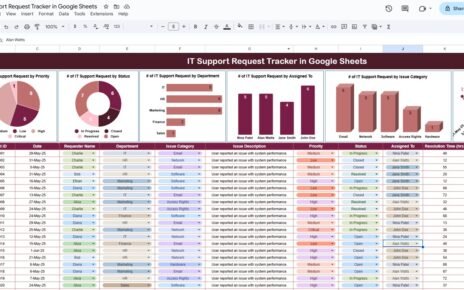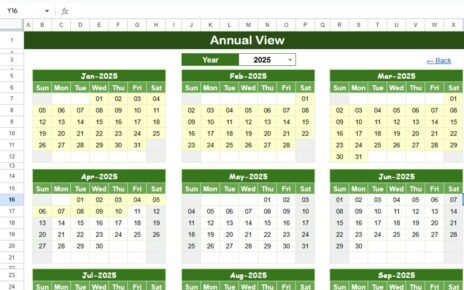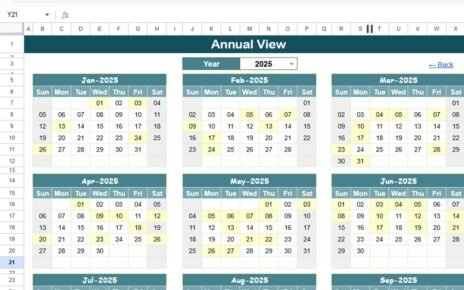Staying organized and consistent in personal or professional life often depends on self-reflection. Weekly reflection is a powerful practice that allows you to pause, evaluate your activities, celebrate achievements, and identify areas for improvement. However, without a structured system, this practice may become inconsistent or even forgotten.
A Weekly Reflection Schedule Checklist in Google Sheets solves this problem. It provides a ready-to-use, digital, and customizable template that guides you through reflection in an organized manner. With built-in tracking, progress visualization, and easy accessibility across devices, it ensures that your weekly reflection becomes a habit rather than a challenge.
In this article, we will explore the features, benefits, best practices, and real-world applications of the Weekly Reflection Schedule Checklist in Google Sheets. By the end, you will have a complete understanding of why and how this tool can improve both productivity and personal growth.
Click to buy Weekly Reflection Schedule Checklist in Google Sheets
What Is a Weekly Reflection Schedule Checklist?
A Weekly Reflection Schedule Checklist is a structured tool that helps you capture and analyze your weekly activities. It goes beyond simple to-do lists by including prompts for reflection, such as:
- What did you achieve this week?
- What challenges did you face?
- Which habits supported your progress?
- What needs improvement for next week?
Instead of managing sticky notes, journals, or multiple apps, this checklist in Google Sheets brings everything together in one place. You can track tasks, monitor completion, assign responsibility, and record observations—all in a single sheet that automatically updates progress.
Key Features of the Template
The Weekly Reflection Schedule Checklist in Google Sheets is simple yet powerful. It includes two main worksheets designed to provide clarity and structure.
Main Checklist Sheet
This sheet is the core of the template. It helps you record your weekly tasks and reflection points in a structured table format.
Top Section (Progress Overview):
At the top, you’ll find three summary cards:
- Total Count – the total number of checklist items
- Completed Count – how many tasks are completed
- Pending Count – how many tasks remain
- Progress Bar – a visual indicator showing the percentage of completion
Checklist Table:
The table includes the following columns:
- Serial No. – for easy tracking of items
- Checklist Item – the reflection activity or task
- Description – short details or context
- Responsible Person – assigned individual (self, team member, etc.)
- Deadline – due date for the task or reflection entry
- Remarks – additional notes or observations
- Status – marked as ✔ (completed) or ✘ (pending)
This structure keeps everything organized and allows you to track both progress and accountability.
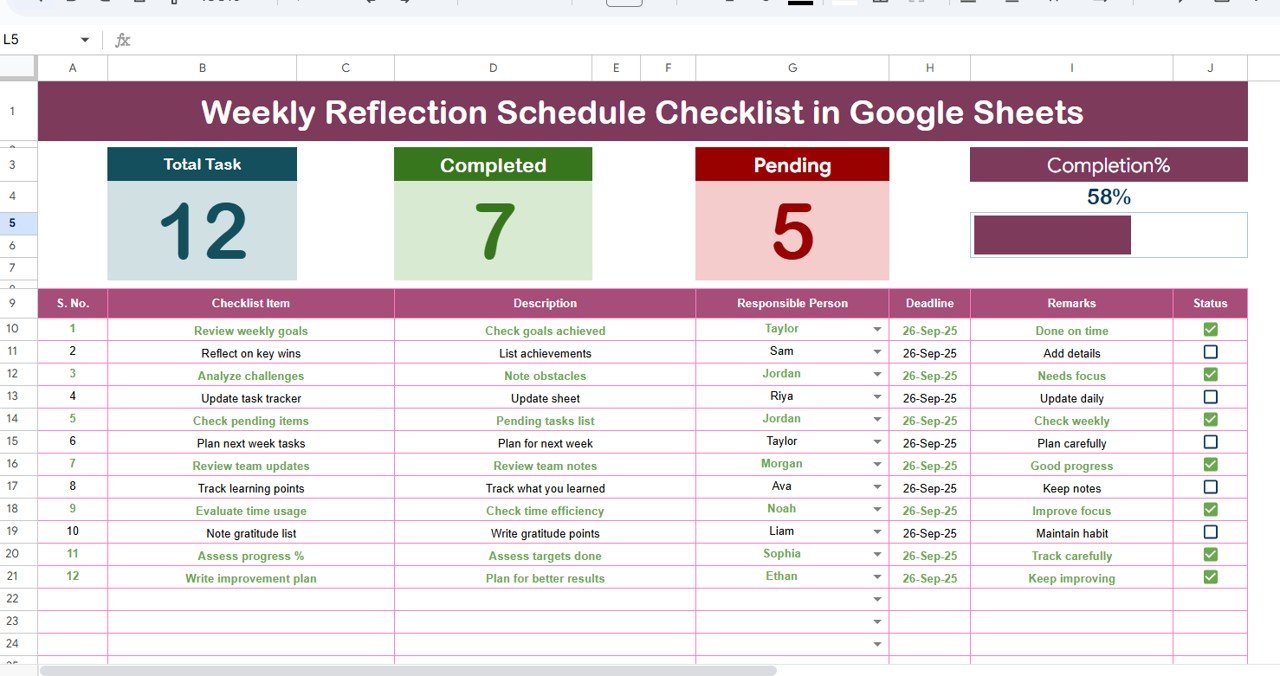
List Sheet Tab
The second worksheet is designed to support drop-down functionality.
- It captures the unique list of responsible persons.
- This ensures consistency and reduces errors in the main checklist.
- You can easily update or add new names without disrupting the main data.
Together, these two sheets create a complete framework for structured weekly reflection and task management.
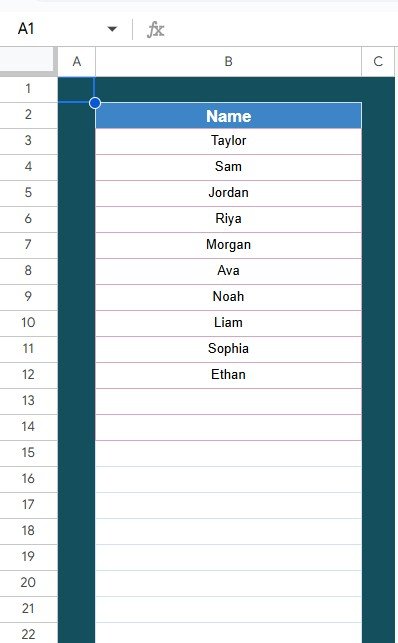
Click to buy Weekly Reflection Schedule Checklist in Google Sheets
Why Use a Weekly Reflection Schedule Checklist in Google Sheets?
Reflection is often undervalued, but it has immense benefits for personal development and team productivity. Using a Google Sheets template makes the process even more effective because it combines structure with flexibility.
Here are a few reasons why this tool is useful:
- Accessibility – Access it anywhere, anytime, from any device.
- Collaboration – Share with teammates or colleagues for joint reflection sessions.
- Customization – Adjust columns, add prompts, or apply conditional formatting.
- Visualization – Use progress bars and counts to stay motivated.
- Automation – Create drop-downs and formulas to simplify updates.
Advantages of Weekly Reflection Schedule Checklist in Google Sheets
Adopting this system offers multiple benefits:
- Improved Self-Awareness – Weekly reflection helps you identify patterns in behavior, productivity, and decision-making.
- Better Goal Alignment – You can track whether weekly activities align with larger personal or organizational goals.
- Enhanced Accountability – Assigning responsibilities ensures that tasks are not overlooked.
- Stress Reduction – Seeing progress in a visual form reduces overwhelm.
- Stronger Team Collaboration – In a workplace, it encourages open discussion of achievements and challenges.
- Consistency in Reflection – Structured format makes reflection a routine rather than an occasional effort.
- Time Efficiency – A ready-to-use template eliminates setup time.
How to Use the Weekly Reflection Schedule Checklist
Using this template is simple. Follow these steps to get started:
- Set Up Your Template
- Open the Google Sheets file.
- Review the two worksheets: Main Checklist and List Sheet.
- Input Reflection Items
- Add weekly reflection tasks or questions under “Checklist Item.”
- Provide a short description if needed.
- Assign Responsibility
- Choose a responsible person from the drop-down list.
- Update the list sheet if new names are required.
- Add Deadlines
- Enter due dates for completing tasks or reflections.
- Update Status Regularly
- Mark tasks ✔ when completed and ✘ if pending.
- The progress bar updates automatically.
- Review Weekly Progress
- At the end of the week, analyze completed vs pending tasks.
- Record observations in the “Remarks” column.
Opportunities for Improvement
While the template is highly effective, there are opportunities to improve it further:
- Add Reflection Prompts: Insert guiding questions like “What went well this week?” or “What challenges did I face?”
- Integrate Charts: Add pie charts or bar charts for task completion analysis.
- Use Conditional Formatting: Apply color codes (green for completed, red for pending).
- Automate Notifications: Use Google App Script to send reminders about deadlines.
- Track Habits: Extend the checklist to include weekly habit monitoring.
Best Practices for the Weekly Reflection Schedule Checklist
To get the most out of this template, follow these best practices:
- Keep It Simple: Do not overload the sheet with too many details. Stick to essentials.
- Update Regularly: Mark progress daily or weekly without delay.
- Encourage Honesty: Be truthful while recording reflections.
- Set Realistic Deadlines: Avoid unrealistic timelines that may create stress.
- Review Collectively (for Teams): If used in a team, review reflections in a weekly meeting.
- Customize for Needs: Adjust the template to suit personal or professional goals.
- Archive Old Weeks: Create copies or move past weeks into an archive sheet for tracking progress over time.
Practical Applications
This template is versatile and can be used in different contexts:
- Personal Growth: Reflect on habits, goals, and learning progress.
- Workplace Productivity: Evaluate weekly projects, deadlines, and collaboration efforts.
- Education: Students can use it to track assignments, study habits, and progress.
- Wellness Tracking: Monitor self-care activities like exercise, mindfulness, and sleep patterns.
- Team Management: Managers can use it for weekly performance reflections.
Conclusion
A Weekly Reflection Schedule Checklist in Google Sheets is more than just a digital sheet—it’s a habit-forming tool that promotes consistency, awareness, and growth. By combining structure with flexibility, it helps individuals and teams stay aligned, accountable, and motivated.
Whether you use it for personal goals or workplace tasks, this checklist ensures that reflection becomes a productive routine. With features like progress visualization, responsible-person tracking, and drop-down functionality, it makes weekly reflection simple and effective.
Frequently Asked Questions (FAQs)
- Why should I use a Weekly Reflection Schedule Checklist?
It helps you evaluate your activities, track progress, and stay consistent with personal and professional goals.
- Can I customize the template?
Yes. You can add new columns, prompts, or formatting as per your needs.
- Is this template useful for teams?
Absolutely. You can assign responsibilities, collaborate, and review progress collectively.
- How does the progress bar work?
The progress bar updates automatically based on the ✔ and ✘ entries in the Status column.
- Can I track habits with this template?
Yes. By slightly modifying the checklist items, you can include habits like exercise, journaling, or reading.
- How often should I update the checklist?
Update it at least once a week. Daily updates are even better for accurate tracking.
Visit our YouTube channel to learn step-by-step video tutorials
Watch the step-by-step video tutorial:
Youtube.com/@NeotechNavigators
Click to buy Weekly Reflection Schedule Checklist in Google Sheets

